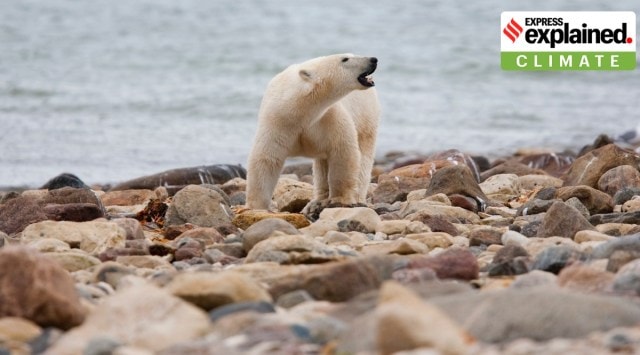Polar bears in key Canada region dying: Causes, effects
The latest survey shows Western Hudson Bay has 618 polar bears, down from 842 in 2016. This has consequences for all other life forms in the region.
 A male polar bear walks along the shore of Hudson Bay near Churchill, Manitoba, Aug. 23, 2010. Polar bears in Canada's Western Hudson Bay — on the southern edge of the Arctic — are continuing to die in high numbers, a new government survey released Thursday, Dec. 22, 2022, found. (Sean Kilpatrick/The Canadian Press via AP, File)
A male polar bear walks along the shore of Hudson Bay near Churchill, Manitoba, Aug. 23, 2010. Polar bears in Canada's Western Hudson Bay — on the southern edge of the Arctic — are continuing to die in high numbers, a new government survey released Thursday, Dec. 22, 2022, found. (Sean Kilpatrick/The Canadian Press via AP, File) Polar bears in Canada’s Western Hudson Bay, an inland sea connected to the Arctic Ocean, are dying at a fast rate, according to a new government survey, the Associated Press reported on Friday. It also revealed that females and younger polar bears are the worst affected.
At the time of the survey, conducted by air in 2021, researchers calculated that there were 618 bears left in Western Hudson Bay — the region includes Churchill, the town that is known as ‘the Polar Bear Capital of the World’. When the last survey took place in 2016, there were 842 bears in the area, the AP report said.
According to the researchers, Western Hudson Bay has witnessed a drop of around 50% in the population of polar bears since the 1980s.
The survey is yet another addition to the long list of reports and studies that have highlighted the vulnerability of polar bears to climate change. An earlier study published in Nature Climate Change in 2020 warned that polar bears will be wiped out by the end of the century.
Impact of climate change on polar bears
The Arctic sea ice is crucial to polar bears’ survival as they use it not only to hunt seals — their chief food — but also for travelling, mating and resting. However, with rising global temperatures, the sea ice is breaking earlier in summer and refreezing later in winter, due to which polar bears get less time to hunt and have to stay hungry for longer and travel greater distances.
This extra need for energy coupled with a lack of food can result in body deterioration and a drop in the average weight of adult bears, according to a recent report published in Carbon Brief, a UK-based website covering climate science, climate policy and energy policy. The report also found that the change in the diet leads to a higher mortality rate of bear cubs.
Another study that came out in 2020 showed that when temperatures soar and there is a lack of ice, female polar bears give birth to smaller litters of bears. It might also lead to the collapse of dens that they build to birth and protect their young.
Importance of polar bears
Polar bears are one of the most significant predators in the Arctic region and they keep biological populations in balance. The big kills made by them serve as a food resource for scavengers like Arctic foxes and Arctic birds. If polar bears aren’t able to hunt animals like seals, it can severely impact the food chain and health of the ecosystem.
Researchers have also found that once polar bears can’t find seals to eat, they would quickly move to kill and survive on other creatures in the Arctic region. This would threaten the existence of species like the Arctic fox or the walrus. Moreover, it might also cause the overpopulation of seals, which could endanger the existence of crustaceans and fish that are an important food source for local human populations as well as other Arctic wildlife.
- 01
- 02
- 03
- 04
- 05






































